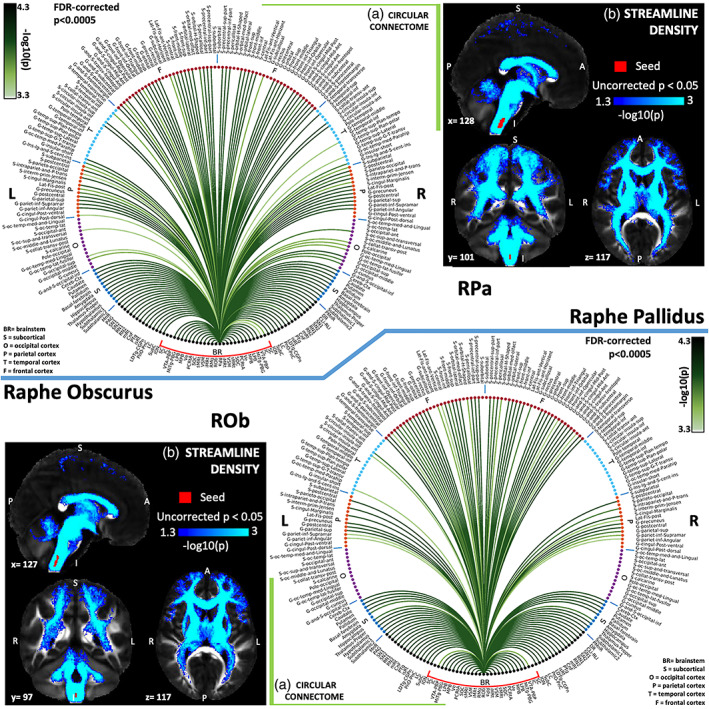FIGURE 8.

(a) Region‐based 2D structural connectome and (b) voxel‐based streamline density map of raphe pallidus—RPa (top) and raphe obscurus—ROb (bottom). Specifically, in (a) we show the −log10(p value) of the Wilcoxon test, thresholded, for display purposes, at p < .0005 false discovery rate (FDR) corrected for multiple comparisons. In (b) we show the −log10(p value) of the Wilcoxon test thresholded, for display purposes, at p < .05; seeds are shown in red and streamlines are shown in blue‐light blue. List of abbreviations of 15 brainstem nuclei used as seeds (marked with red brackets in Figure 1a,b): superior colliculus (SC), inferior colliculus (IC), ventral tegmental area‐parabrachial pigmented nucleus (VTA‐PBP), microcellular tegmental nucleus–parabigeminal nucleus (MiTg‐PBG), lateral parabrachial nucleus (LPB), medial parabrachial nucleus (MPB), vestibular nuclei complex (Ve), parvicellular reticular nucleus‐alpha part (PCRtA), superior olivary complex (SOC), superior medullary reticular formation (sMRt), viscerosensory motor nuclei complex (VSM), inferior medullary reticular formation (iMRt), raphe magnus (RMg), raphe obscurus (ROb), and raphe pallidus (RPa). List of abbreviations of 18 additional brainstem nuclei used as targets: median raphe nucleus (MnR), periaqueductal gray (PAG), substantia nigra‐subregion1 (SN1), substantia nigra‐subregion2 (SN2), red nucleus‐subregion1 (RN1), red nucleus‐subregion2 (RN2), mesencephalic reticular formation (mRt), cuneiform nucleus (CnF), pedunculotegmental nucleus (PTg), isthmic reticular formation (isRt), laterodorsal tegmental nucleus–central gray of the rhombencephalon (LDTg‐CGPn), pontine reticular nucleus, oral part–pontine reticular nucleus, caudal part (PnO‐PnC), locus coeruleus (LC), subcoeruleus nucleus (SubC), inferior olivary nucleus (ION), caudal–rostral linear raphe (CLi‐RLi), dorsal raphe (DR), and paramedian raphe nucleus (PMnR)
